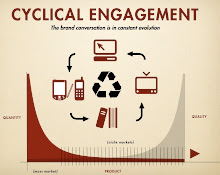
Given the current state of our social technology landscape, it seems that a new model is emerging that sheds very serious light on consumer control and activation; it is comprised of:
- Premium long-tail content developers (influencers, super-users and 'prime' blog networks)
- Content aggregation platforms (Facebook / FriendFeed )
- Conversation & social search engines (Twitter / Google Caffeine / Collecta et al)
The idea is that content developers will keep developing more premium content to cut through the clutter and saturation of mediocre mid-tail content. Conversation and social search engines will continue to filter the good content from the not-so-good content, and aggregators will give users ease-of-use and relevancy, such as dynamic comment threads, in order to interact and spread this premium content.
- Content aggregation platforms (Facebook / FriendFeed )
- Conversation & social search engines (Twitter / Google Caffeine / Collecta et al)
The idea is that content developers will keep developing more premium content to cut through the clutter and saturation of mediocre mid-tail content. Conversation and social search engines will continue to filter the good content from the not-so-good content, and aggregators will give users ease-of-use and relevancy, such as dynamic comment threads, in order to interact and spread this premium content.
So why call it 'micro media' (which is not a new term, by the way...)? For three main reasons:
1. The lines between content and delivery are becoming more blurred, to the extent that these 'packets' can live in shorter bursts, or be digested in smaller, more relevant bits.
2. The portability of these packets allows them to be dynamically and semantically indexed into search, most often in real-time and also re-threaded through content or commentary streams (like FriendFeed).
3. Further, these content streams will be reshaped so that new semantic layers will build up (think of a new form of cookies) a value chain that is unique to each and every user, and will not only have topical relevance, but one that will represent a new relationship between local markets and niche categories.
Micro media give influencers more targeted reach, as well as the ability to tap into niche markets that represent degrees of conversation - people in their social graph and relevant communities. As such, we will see a dramatic rise of super-users and common interest communities (tribes), and in using social technologies such as monitoring platforms, for example, we will then be able to accurately map groups of people (social graphs) that we can then target with more meaningful and useful information and content, which of course they can then spread to their peers, and their peers, and so on.
Ultimately, as the players within the landscape narrow and more consolidation takes place, new channels will form that offer more utility for creation and use. Whether or not networks and agencies play a role in this - at least as we know them - is anyone's guess. But one thing is for sure... if you're a brand, you definitely don't want to be late to the party.
Ultimately, as the players within the landscape narrow and more consolidation takes place, new channels will form that offer more utility for creation and use. Whether or not networks and agencies play a role in this - at least as we know them - is anyone's guess. But one thing is for sure... if you're a brand, you definitely don't want to be late to the party.
Thoughts? Reactions? Upheavals?







